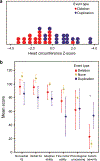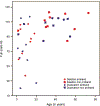Clinical phenotype of the recurrent 1q21.1 copy-number variant
- PMID: 26066539
- PMCID: PMC7263044
- DOI: 10.1038/gim.2015.78
Clinical phenotype of the recurrent 1q21.1 copy-number variant
Abstract
Purpose: To characterize the clinical phenotype of the recurrent copy-number variation (CNV) at 1q21.1, we assessed the psychiatric and medical phenotypes of 1q21.1 deletion and duplication carriers ascertained through clinical genetic testing and family member cascade testing, with particular emphasis on dimensional assessment across multiple functional domains.
Methods: Nineteen individuals with 1q21.1 deletion, 19 individuals with the duplication, and 23 familial controls (noncarrier siblings and parents) spanning early childhood through adulthood were evaluated for psychiatric, neurologic, and other medical diagnoses, and their cognitive, adaptive, language, motor, and neurologic domains were also assessed. Twenty-eight individuals with 1q21.1 CNVs (15 deletion, 13 duplication) underwent structural magnetic resonance brain imaging.
Results: Probands with 1q21.1 CNVs presented with a range of psychiatric, neurologic, and medical disorders. Deletion and duplication carriers shared several features, including borderline cognitive functioning, impaired fine and gross motor functioning, articulation abnormalities, and hypotonia. Increased frequency of Autism Spectrum Disorder (ASD) diagnosis, increased ASD symptom severity, and increased prevalence of macrocephaly were observed in the duplication relative to deletion carriers, whereas reciprocally increased prevalence of microcephaly was observed in the deletion carriers.
Conclusions: Individuals with 1q21.1 deletions or duplications exhibit consistent deficits on motor and cognitive functioning and abnormalities in head circumference.Genet Med 18 4, 341-349.
Conflict of interest statement
DISCLOSURE
The authors declare no conflict of interest.
Figures


References
Publication types
MeSH terms
Grants and funding
LinkOut - more resources
Full Text Sources
Other Literature Sources

